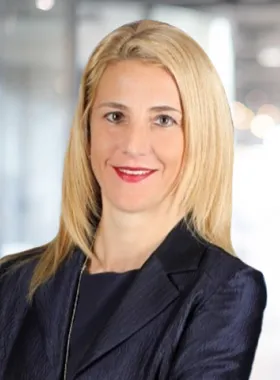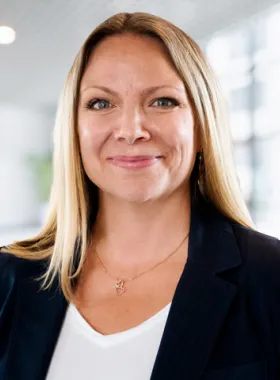- 1. Revisiting the concept of the “citizen supply chain”
-
Peter Warren
Hello everyone, welcome back to part two of our series exploring how we are discussing the citizen supply chain. In part one we talked about what a citizen supply chain is, and we did our best to define it because it's a very wide and complicated component. We finished part one with Charley giving a great definition of how this is moving in and impacting and how companies are looking to adapt to this. Helena, I promised we'd come back to you in part two and pick up some client examples.
- 2. Evolving client needs, agility and the shift to Industry 5.0
-
Peter Warren
Are clients changing the way they're looking at the supply chain? Is it something they care about? Are they doing it every year? What's happening?
Helena Jochberger
Yeah, definitely. There's a lot going on. And I would say let's pick one of our large clients, Michelin. It's one of our oldest clients. And the way they looked at their supply chain in the past was in the average frame of three to five years. Meanwhile, and also after the pandemic, this has changed to a very short-term perception on looking at the supply chain, namely in two months. So, three, four months, and sometimes even down to weeks.
And that means, of course, when you want to look at your supply chain and even make changes. So, take your supply chain to a more agile point of view so that you're able to switch from supplier A to supplier B that needs the data for it. So of course, the endeavors that we have taken the last years between 2010 and 2020 where we were talking about industry for the sort of the fourth industrial revolution that continues to take place because what has been there in these first 10 years of digital transformation was that we had a lot of proof of concepts, right? We had proof of concepts in various parts of the value chain, might it be in R &D or in the production or also in the after sales.
But what is still missing here is also what we call industry 5.0 or the next level of industrial revolution, namely becoming fully data driven as an enterprise throughout the entire enterprise. And that demands, of course, systems integration from the various core systems you have to generate that system’s interoperability and that data continuity. And that is not only within my own company the case, but when we're talking about ecosystems, we need to extend that data continuity throughout the ecosystem. And I think in so far, the supply chain is also pushing that next level of transformation right now.
- 3. Laying the foundation and climbing the knowledge ladder
-
Peter Warren
I know that we haven't mentioned the ever-popular word of AI, but we do see that people are applying that demand for data to their ecosystems now, their supply chains to determine what moving forward. So, I guess when Michelin was looking at their supply chain every couple of years, data wasn't a key factor. So, it must be exponentially more important to them. Are they looking at using new tools or are other ones of your clients looking to use new tools for this type of function?
Helena Jochberger
Definitely. What I would say first is, and this is what we see throughout the globe currently, the homework of getting the data strategy and the data management or data governments in place. I would say that is the foundation. Once this has been built, then of course we can climb the knowledge ladder so that we can introduce advanced analytics within the supply chain. And then we are getting in the area or in the domain of scenario planning, multi-scenario planning.
So, think about the digital twin, for example, if you have just the IT or the virtual representation of the physical chain and then bring AI into the game and come up with all sorts of recommendations, also in terms of financial aspects. When we talk, for example, if supplier A is not able to deliver that or to bring that from A to B in that time frame, what kind of financial loss do I have as a company? What kind of liabilities do I have, what kind of penalties do I have. So, these aspects I think are very important. And on the other hand, what we also saw from our voice of the client analysis this year quite clearly is that double-sided coin on the one hand due to that in parts of the world economic crisis I would say, we need to be very cost efficient. So, our manufacturers are very sensitive when it comes to cost. They need to have their return on investment in months.
Earlier it was years for their investments and on the other hand they wanted to diversify into new markets with new product lines. So that means of course you need to do some sort of consolidation also in the chain, in the supply chain, in the vendor chain. So, this is more the financial engineering part and then you need to have the money for investment to go into diversification where you need the strong chains to be able to produce, to be able to source the raw material and such. So, I would say it's the two sides of the coin.
- 4. Digital twins, triplets and exponential thinking
-
Peter Warren
Yeah, I agree with you and we—Diane Gutiw, you—just published an article about digital triplets. You talked about the digital twin. For those that don't know what a triplet is, a digital twin is modeling a process, and you might have a series of those. The triplet looks at a series of those as input to make a third or fourth decision. So, if I'm looking at my supply chain, but I'm looking at also my energy demands, I'm also looking at my HR considerations. I might have individual models of each of those. The triplet is a third thing that says, what's the business importance of me for this factor? What is the outcome of all of those? What should I consider doing next based on all this disruption? And we see a big play of that. Charley, you've got a cross-industry viewpoint of everything that we do. How do you see that coming together from not just manufacturing or my selfish needs of energy and utilities? How do you see that kicking across all the industries you look after?
Charley Wark
Well, I saw an interesting report coming out from the Harvard Business Review. If we circle back to the importance of the supply chain, Harvard Business Review in September, I think it was, identified the CEOs that they have interviewed identified the supply chain resilience as a key factor to predict whether a company was going to have growth over the next three years. So, if you take what you just said, Peter, digital triplets, the ability to look at understanding of how something happening right here, how that plays out in an exponential fashion, then clearly the company that has their data in order can use AI to have digital twins and digital triplets. Clearly, that is a sign of a company that will be set up for future growth. So, this is important today and it will become even more important in the future.
- 5. Real-time collaboration and the rise of data ecosystems
-
Peter Warren
So, with that change, cooperation across industry, I think, is becoming a reality. I know that for me to predict energy demands, we've got some emerging things where we have connections to key clients saying, hey, you're going to run your factory now. And I might have a surplus in the future. You can run things then. But I think the tight-knitted nature of this is going to have to accelerate. What's your point of view about that? Do either one of you have an idea?
Helena Jochberger
Yeah, let me bring into the discussion the concept of data spaces or of collaborative ecosystems. And I think we have seen nicely that with ecosystems like, for example, German founded and funded Catena-X solution. So that goes under the European Gaia-X umbrella. The need for data sovereignty on the one hand side so that every participant can decide which data is going to be shared. Data security on the other hand side, but strong will for partnerships or for collaboration is key. And Catena-X was in so far, an interesting example because this has been founded in 2021, just in the middle or slash after the pandemic, where first large automotive OEMs joined forces and said, “Our chains, our supply chains are so weak, and we have one of the most complex supply chains in the world. So how could we do better?”
And so, they formed, but not only in the automotive space, no, they took also tech corporations on board like SAP, like BASF, chemical companies and others. And meanwhile, this whole concept spreads. So, the entire technological and platform foundation has been built. CGI has also been a partner from the very beginning in two cases. So, the one is around the digital data passport. So, to have a clear denomination of where a part comes from, what kind of CO2 footprint it had and such. So that's more coming from governmental need. But there is the second use case, which I found personally in our discussion even more interesting, and that's called the demand and capacity management use case. How can we join forces, not only the OEMs, but also the tier X suppliers in the chain, to really have a breathing supply chain. So according to the demand that comes in from the order side, how can we ramp up? Ramp up and ramp down in times of need. And this is a little bit where we are still lacking also in the business model of production. And we hope, of course, by onboarding more and more suppliers, and that whole thing is spreading right now via hubs in France, via hubs in North America, in China, in Japan.
Helena Jochberger
We hope with the onboarding of these suppliers that we get real traction into that data ecosystem so that the effective collaboration and the benefits will show. So, this is just a little example, but I'm pretty sure, Peter, you have ones in your industry as well.
- 6. Cross-industry data sharing, risk visibility and real-time ecosystem opportunities
-
Peter Warren
But what I like about the Catena-X example is they didn't just look at the automotive industry. There are elements in there for the energy market and so on. And when you talk to our counterparts or peers both in the insurance industry and in the financial industry, if we had better connections with them, if I understood my risk profile better, I might get better rates. So, can I share data that tells my insurer that I'm having lower risk here, so charge me less, but could I also share that data and say, hey, you've got a risk that you're not covering?
And here's your exposure from a business standpoint that I could offset for you. Similarly, if I had better data into the banking, could I give you a better rate because you really are investing in the types of things that I want to invest in and I'm seeing this, not just a yearly report you say that you did this, but how could I do things in more real time? And I think Charley, this is where you were going too. It's into this ecosystem, this supply web or supply ecosystem of real-time data sharing beyond what we're currently doing.
Charley Wark
Let's dream here: imagine if we as a citizen would be able to see our own personal data that exists anywhere in the public sector. Imagine if we instead of having to go and ask questions or be educated on if I'm allowed to apply for, I don't know, a student visa to a country or a student loan if I'm a student. Imagine if...
All those things would just happen automatically just with smart contracts that's built into a supply chain or a supply web of information of my personal data. I think that my friends would be the end of bureaucracy in this world. So, if you want to dream big, I think that could be a vision that we could also give our listeners today.
- 7. Purpose, collaboration and future-ready supply chains
-
Peter Warren
It’s proactive, it's not reactive. How do it, how do, so, and I like, maybe this is a good point for us to end on, and I'll give you both a chance to sort of wrap this up, but this is moving beyond the mundane beyond the reactive beyond whatever into a proactive environment which requires the cooperation like a Catena-X it requires the Realization that is I'm not in a bubble. I am part of a larger story. I'm part of the citizen supply chain, to your point earlier Understanding my role as an organization is a key factor of this; it's not just my selfish view of what I want to do. It's how I'm benefiting the rest of the world with that would either like either one of you like to start with a summary and we'll head towards the end of this.
Charley Wark
Well, I think Peter, already started my summary is like for a company to understand their part in the citizen supply chain, I think that will be crucial, but also to be able to leverage the technology that already exists and have existed existing for a really, really long time where we have the ability to leverage technologies like AI, blockchain, smart contracts.
All these kinds of things to create a better environment and a better future for our citizens and also for the companies that operate within our countries. I think that it is our duty to come or show all the opportunities and possibilities that are out there.
Helena Jochberger
And just to add what Charley just said, because I really like that duty on the one hand, but it can give also purpose. Yeah. If we know what crucial part, we play in the criticality of a functioning society that can give you purpose. And I would say we are challenged with so many things around in our industries and our societies and believing in the power of strategic partnerships, believing in collaboration and interdisciplinary collaboration. This is something for me or my takeaway where I want to believe in and that is the world I'm working for.
Peter Warren
That was a great summary from both of you. I’d like to thank you Charley and thank you Elena for participating today and thank you to everyone that listens. Feel free to contact us if you have any thoughts or feedback on this and thank you for your time. Bye.
Helena Jochberger
Thanks for listening, bye.
Charley Wark
Bye.










